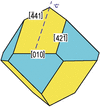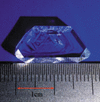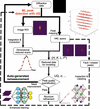issue contents
April 2023 issue

Cover illustration: Hao et al. [J. Appl. Cryst. (2023), 56, 519–525] present a machine-learning-assisted data reduction and analysis procedure for single-crystal neutron diffraction. The model allows precise recognition of Bragg peaks and the corresponding regions of interest; it can then automatically screen and align a measured crystal using the recognized peaks, and subsequently plan and optimize the data collection.
research papers
An approach to simulate pair distribution functions of discrete particles using a crystalline model is presented.
This paper reports a re-evaluation of the epitaxy between anhydrite (CaSO4) and the {10.4} rhombohedron of calcite.
Open  access
access
 access
accessThe lattice parameters of more than 350 phases have been determined from simulated backscatter Kikuchi patterns. The deviations correlating with the mean atomic number correspond to those observed previously for experimental electron backscatter diffraction patterns.
Open  access
access
 access
accessAutomatically determined band widths in simulated backscatter Kikuchi patterns exhibit differences from the double Bragg angles that correlate with the scatterer density. Corrections are proposed to compensate for this.
Open  access
access
 access
accessDistinguishing between actual and apparent pseudosymmetry in electron backscatter diffraction patterns is nearly impossible, even for simulated patterns. However, the resulting lattice is always a superlattice as long as the signal is not a superposition of multiple patterns.
Open  access
access
 access
accessThe possibilities offered by three coherent X-ray diffraction experimental setups applied to micropillar compression are discussed here. The yield stress was precisely determined with a collimated beam. Methods to deconvolve the signal coming from the pillar from that coming from the pedestal and to estimate in situ the curvature radius of the micropillar are also proposed here.
Takagi–Taupin dynamical X-ray diffraction simulations of crystals with surface undulations show that the influence of the surface undulations is local for those in the low-frequency range and can be predicted by classical X-ray dynamical theory.
Synchrotron radiation rocking curve imaging on a highly perfect CdTe(Zn) crystal has been used to study the signatures of second-phase defects and dislocations in this high-absorption, Borrmann effect case. Using both the Borrmann image and the weak-beam image, the depth of the defect within the crystal could be determined. This knowledge acquired on a crystal with only a few defects allows a better understanding of the more complex defect structures present in other crystals.
Open  access
access
 access
accessA new artificial-intelligence-based platform, CrystalMELA, that can implement machine-learning models has been developed. Powder X-ray diffraction patterns of organic, inorganic and metal–organic compounds and minerals were used to train and test the learning models, and CrystalMELA has been employed for crystal system classification.
This work proposes a new way of assessing bond lengths, valence angles, torsion angles and molecular conformations using crystallographic distributions.
The optical rotation parameters of the lithium triborate nonenantiomorphous biaxial crystal along one of the optical axes and birefringence directions have been investigated by the dual-wavelength polarimetric technique.
Open  access
access
 access
accessMonte Carlo modelling of grazing-incidence small-angle X-ray scattering intensity provides detailed information on the cross-sectional size and shape distributions of GaN nanowires, as well as the roughness of their side facets. The cross sections are found to be dodecagons rather than hexagons. A narrow orientational distribution of the nanowires is found using X-ray diffraction. In addition, a variety of different topotaxial crystallites with in-plane and out-of-plane lattice parameters intermediate between those of Al2O3 and GaN are revealed in the sputtered Ti film.
Open  access
access
 access
accessSerial crystallography, in which X-ray diffraction data are recorded from a sequence of microcrystals in serial fashion, requires a platform for sample delivery. This work describes a simple flow cell device designed to deliver protein microcrystals to an X-ray beam during serial X-ray crystallography studies using synchrotron radiation.
Open  access
access
 access
accessIn this work, the structure factors of carbon black (CB) and Zn were estimated independently in poly(styrene-ran-butadiene)/CB systems containing Zn using the anomalous small-angle X-ray scattering method. The particle structure factor obtained for CB revealed that the CB aggregates consist of close-packed CB primary particles. Large particles of ZnO and particles of ZnS were identified and found to be on the order of 10 nm in size.
Download citation


Download citation


Centimetre-size (maximum dimensions of 2.1 × 0.9 × 0.4 cm) levoglucosan single crystals of high quality were grown by the solution method, laying a necessary foundation for experimental measurements of the glass transition mechanism in the material.
An approach to recover the orientation matrix of a single crystal by using neutron transmission spectra recorded during rotation of the crystal about an axis perpendicular to a polychromatic neutron beam is presented.
A new method to recover the orientation matrix of a single crystal using time-of-flight neutron transmission spectra is employed on experimentally recorded data of copper specimens.
Open  access
access
 access
accessModelling the structural disorder in trigonal-prismatic coordinated transition metal dichalcogenides
The structural disorder in trigonal-prismatic coordinated transition metal layered dichalcogenides is investigated. The structural model taking into account stacking faults, correlated displacement of atoms and average crystallite size is assessed by fitting to the X-ray diffraction pattern of an exfoliated–restacked MoS2 sample.
Open  access
access
 access
accessAn inclined geometry is investigated for X-ray total scattering measurements using a digital flat-panel area detector. The inclined geometry enables acquisition of higher quality data for simultaneous Rietveld refinement and total scattering studies, yielding structural information on the short-, medium- and long-range orders from one single measurement.
This work presents a machine-learning-assisted data reduction and analysis procedure for DEMAND, a single-crystal neutron diffractometer with a large-area position-sensitive detector at the High Flux Isotope Reactor, Oak Ridge National Laboratory, USA. This is a critical step to automate single-crystal neutron diffraction.
Open  access
access
 access
accessThe single-crystal elastic anisotropy and the anisotropy of the near-surface (residual) stress state of polycrystalline materials with random texture are exploited in energy-dispersive X-ray stress analysis to study samples under constrained measurement conditions.
Because of the significant difference in the piezoelectric moduli between lithium niobate and lithium tantalate, variation of the piezoelectric properties in local regions of the crystal can appear. A correlation between the change in the piezoelectric properties and the composition in a mixed lithium niobate–tantalate crystal was established.
This work extends the application of atomic pair distribution function (PDF) techniques to systems of nanoparticle-based materials. The nano-PDF analysis method provides an effective route to revealing not only nanoscale but also mesoscale structural properties, such as the morphology of a nano-assembly. The approach is of relevance to research fields such as nano-object (e.g. colloids, micelles, proteins) based materials and small-angle scattering.
computer programs
Open  access
access
 access
accessCX-ASAP is a new open-source software project designed to greatly reduce the time required to analyse crystallographic data collected under varying conditions. This software will allow the rapid refinement and finalization of dynamic crystallographic experiments.
Open  access
access
 access
accessA modular and extensible research data management toolbox based on the programming language Python and the widely used computing platform Jupyter Notebook has been established for the acquisition, visualization, analysis and storage of small-angle X-ray scattering data.
addenda and errata
Open  access
access
 access
accessAn error in Fig. 2(b) in the paper by Hulbert & Kriven [J. Appl. Cryst. (2023), 56, 160–166] is corrected.
crystallographers
Free 

Free 


 journal menu
journal menu















































